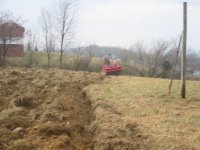 Latte and Pumpkin have settled into their new home and are having quite a lot of fun playing and exploring outside. When they first arrived, they received their first CD&T vax, so I could watch and administer their booster 2 weeks later. They handled it just fine, though Latte developed a small lump in reaction.
Latte and Pumpkin have settled into their new home and are having quite a lot of fun playing and exploring outside. When they first arrived, they received their first CD&T vax, so I could watch and administer their booster 2 weeks later. They handled it just fine, though Latte developed a small lump in reaction.The boosters I gave them on Sunday, March 12, went relatively smoothly, considering I'd never done it before. I put the goats on my lap, with my husband holding them in place, leaving my hands free to pull the skin and inject the vax. Latte was first, and she jumped free after only half the booster, so, unfortunately, we had to repeat to complete the injection. Pumpkin's shot went much more smoothly, injecting in one shot, and I was able to really rub it in as he munched begrudgingly on some cracked corn. They continued to play for the rest of the afternoon and ate dinner happily.
By the next morning, however, Pumpkin Pie was limping, refusing to use the leg on the vax side at all. After talking to two friends, I gave him an aspirin and posted to a goat list (goats@listproc.wsu.edu) for advice. After some great replies, I opted to wait and watch a few days as temporary lameness seems to be a potential reaction to the shot. Because Pumpkin was still eating eagerly, moving around, chewing his cud and generally acting fine other than the lame leg, I felt relatively comfortable about continuing to watch him closely and giving him an aspirin daily to help relieve some of the pain and stiffness.
Late in the week, he began walking tentatively on the leg, and by the end of today, 7 days after the booster, he was running and jumping as if nothing had happened. Adventures in CD&T come to a happy conclusion.





